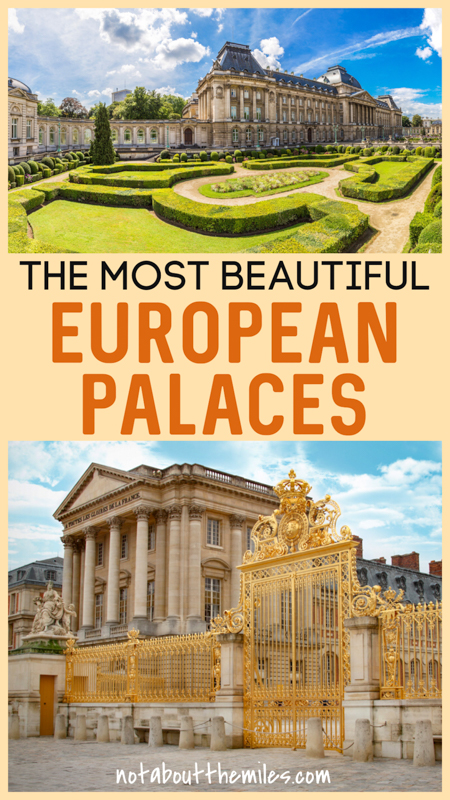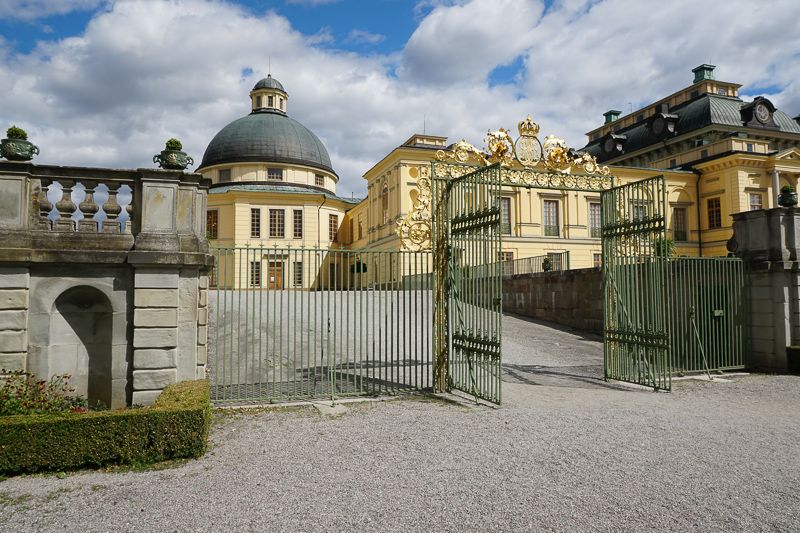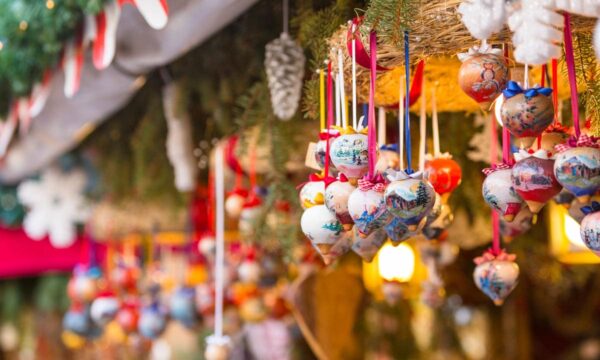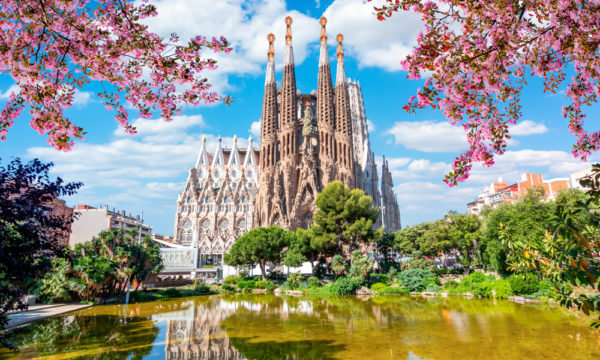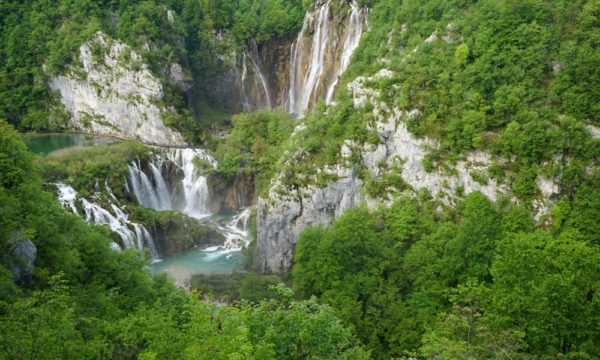Planning a trip to Europe? Make sure you put some of these iconic palaces in Europe on your itinerary!
From the Château de Versailles in France to Buckingham Palace in England, and from Schönbrunn Palace in Austria to Topkapi Palace in Istanbul, these magnificent European palaces will wow you with their beauty, their history, and their grandeur.
The Most Unforgettable Palaces in Europe
Europe’s palaces have long attracted visitors from all over the world, who come to soak in the ambience and admire the art and architecture. Like others, we’ve been enticed into quite a few European royal residences, and we have been captivated by every single one we’ve visited so far.
For this article, we got together with fellow bloggers from the travel blogger community, to put together a list of the most unforgettable palaces in Europe.
Based on the recommendations we received, we have placed a few palaces we haven’t yet visited on the list for our next trip across the pond.
Want to learn more? Let’s get started on discovering the most visit-worthy palaces in Europe!
Real Alcazar de Sevilla, Spain
The Reales Alcázares de Sevilla, the royal palace complex in the Andalusian capital of Seville, is one of the foremost examples of Mudéjar architecture on the planet.
The palace is still used as a royal residence by the Spanish royals when they visit the city.
Exploring the Alcazar should be at the top of your list of things to do in Seville!
The Mudejar style combines Romanesque, Gothic, and Renaissance architecture with the ornamental designs developed by the Muslims of Al-Andalus. The result is, quite simply put, breathtaking.
From the lacy arches and formal reflecting pool of the Courtyard of the Maidens, to the gorgeous interlaced wood pattern of the ceiling in the Hall of the Ambassadors, and from the royal baths of Doña Maria de Padilla to the enormous tapestries in the Gothic Palace, the Alcazar will leave you astounded.
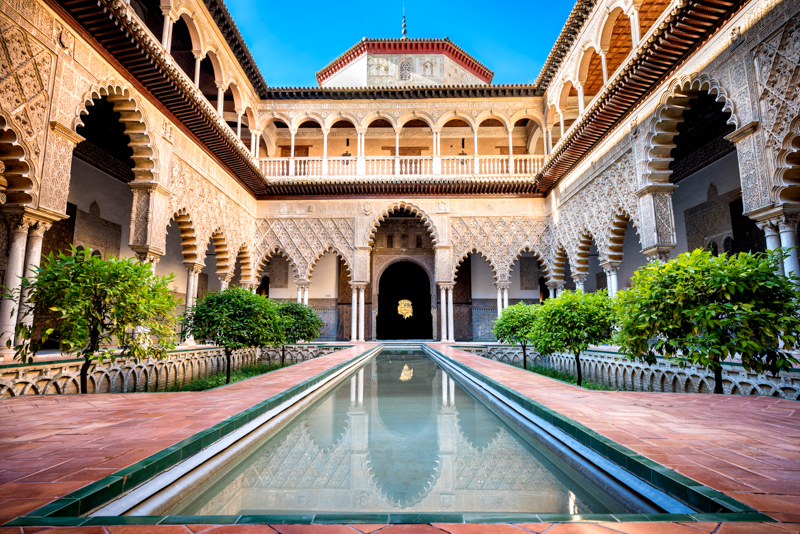
Some links on this page may be affiliate links. If you click an affiliate link and make a purchase, we may receive a small commission, at no extra cost to you. For more details, refer to our disclosure.
The gardens of the Seville Alcazar are no less stunning. Architectural elements combine with formal boxed-hedge plantings, an orangerie, and lovely water features to invite strolling and lingering.
Together with the Seville Cathedral and the Archive of the Indies, Seville’s Real Alcazar is designated a UNESCO World Heritage Site. If you are planning a trip to Seville, make sure you allow plenty of time in your Seville itinerary to explore this remarkable palace complex!
The Alcazar is located in the historical center of Seville, close to other major sights, and within walking distance of several neighborhoods. But you can also arrive here by taxi, or by public transport, including the metro, bus, train, or tram.
Visit in the spring to experience the gardens at their gorgeous best. Fragrant jasmine and citrus scent the air, and daytime temperatures are pleasant for strolling outside. Fall or winter are also good times to visit.
PRO TIP: Visit early or late in the day, especially if you visit in high season. For the best experience, do a guided private tour to learn about what you are seeing. It’s really worth the splurge!
Suggested by us
Schönbrunn Palace, Austria
Vienna is one of the best cities in Europe to visit for its palaces, and one of the most magnificent palaces in all of Austria is the Schonbrunn Palace, located in Vienna.
From the first glance at its bright yellow facade, it’s easy to tell that this is a palace fit for kings and queens. It’s a must on any Vienna itinerary!
Schonbrunn began as an imperial hunting lodge, but grew into a much larger and more impressive palace over the centuries, as royals used it as a summer residence.
As you tour the palace itself, you’ll see some of the over 1,000 state rooms with their gorgeous artwork, ornately decorated ceilings, and gold plated furnishings. Wander through the imperial apartments and learn more about how the royals lived and worked.
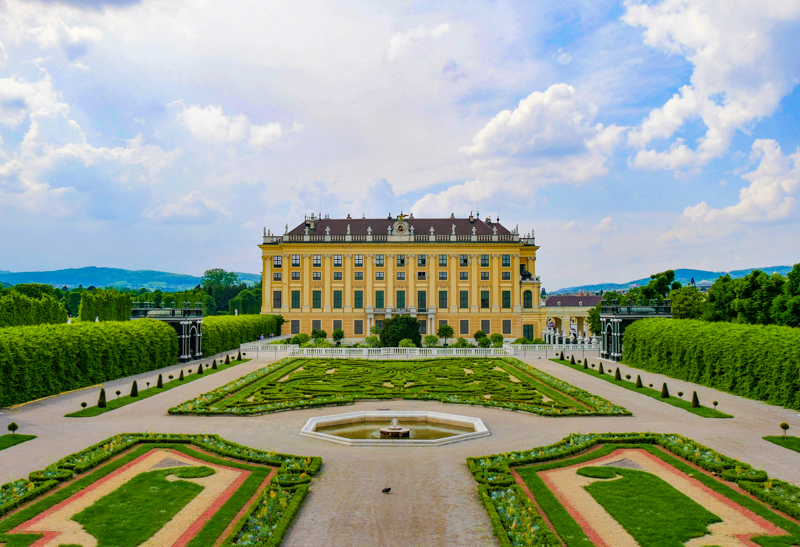
Perhaps the most impressive part of the palace, besides the spectacular exterior, are the gardens. They are vast and made up of multiple flower gardens, an entire park, special vineyards, mazes, and a palm house.
The park at the palace is one of the best free things to do in Vienna, but entrance to the specialty gardens is at a cost, along with the palace itself.
Schonbrunn is easy to get to, as it has its own tram, bus, and underground stops. It lies to the southwest of Vienna’s city center, and the journey takes about 20 to 30 minutes depending on the route you take.
The best time to visit Schonbrunn is in the late spring and summer months when you can take full advantage of the gardens and viewing spots.
Go during a weekday in the mornings if you have the flexibility, as this is a crown jewel in Vienna’s cap and can become very popular on the weekends and as the day goes on.
PRO TIP: The best local secret is the view from the Gloriette, another beautiful structure in the gardens of the palace. Climb to the top and get gorgeous views of the palace, the gardens, and Vienna.
Text and photo by Kalyn from Girl Gone London
Château de Versailles, France
The Palace of Versailles is one of the most impressive buildings in the whole of France, with breathtaking exteriors, stunning interior decor and spectacularly manicured gardens wowing you again and again as you move through the site.
Originally built as a simple hunting lodge, what we see today as the Palace of Versailles is the structure that was created for Louis XIV in the late 1600s and which was the primary residence for the king and his royal court and government.
The palace is now a UNESCO World Heritage Site, and when you visit, you have the chance to witness the opulence in which King Louis XIV lived. Admire the royal apartments, the Hall of Mirrors, the Royal Opera and the Grand Trianon and Petit Trianon.
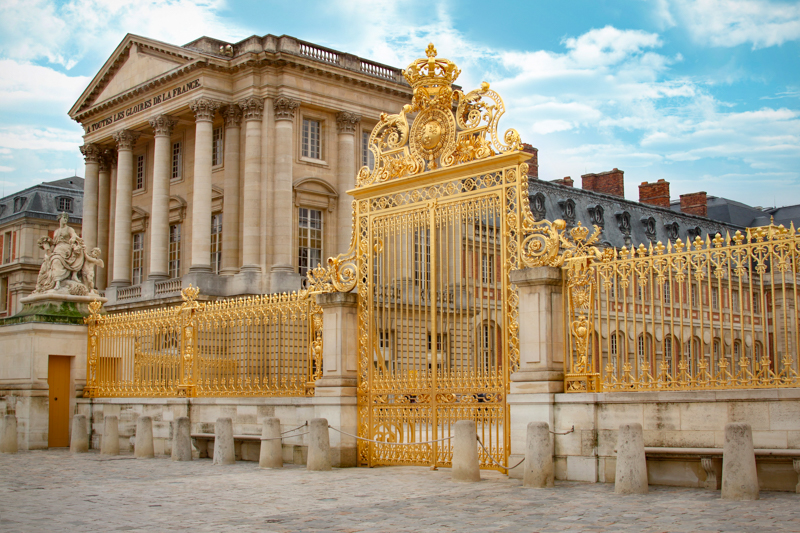
You can easily reach the Palace of Versailles on a day trip from Paris by taking the RER train from Central Paris to Versailles-Chantiers. Or you can drive (around one hour) from the city to the town of Versailles.
Versailles can get extremely hot and busy in summer so visiting in the spring or fall is ideal. Plan to leave the city early in the morning so that you can arrive at Versailles before the crowds and spend as long as you wish exploring the chateau and grounds.
PRO TIP: Book a guided tour or skip-the-line ticket so you don’t have to waste time standing in a queue when you should be in there soaking up King Louis’ lavish lifestyle!
Text by Chrissy from All About Castles
Alhambra de Granada, Spain
A palace and fortress complex located in the Andalusian city of Granada in southern Spain, the Alhambra is a must-visit on your Granada itinerary.
Together with the historic neighborhood of the Albayzin, the Alhambra palace complex and its Generalife Gardens are designated a UNESCO World Heritage Site for their stature as symbols of Moorish Spain.
The hilltop Alhambra is so called because of the reddish hue of its walls. The earliest structure in the complex is the Alcazaba, or fortress. The strategic location offered views over the city and the surrounding countryside.
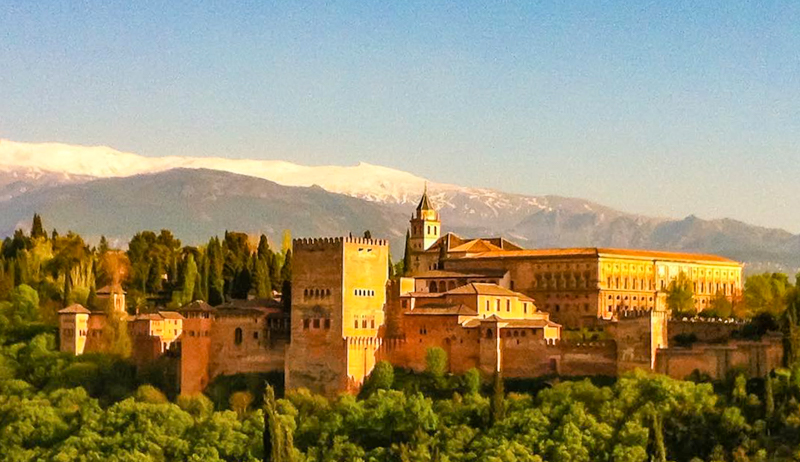
In the 13th century, the rulers of Granada established their residence at the Alhambra, and thus began its expansion. In the 14th century, some of the most iconic portions of the complex, such as the Nasrid Palaces and the Patio of the Lions, took shape.
After the Christians took control of Granada, King Charles V demolished a part of the complex to replace with the palace named after him.
The Nasrid Palaces are the crown jewel of the complex, with courtyards and reflecting pools, and the most fabulous architecture and embellishments you can imagine. They have to be visited during a pre-booked time slot.
The Generalife Gardens are gorgeous, especially in the spring, when blooming trees and flowers add color to the landscape. Beautiful fountains in formal settings offer great areas to relax.
The Alhambra complex is accessible on foot from the city center of Granada, but if you do not wish to make the uphill trek, you can take a bus or a taxi up to the entrance.
The best time to visit is in the spring, when temperatures are pleasant and the gardens are in bloom. Fall is also a nice time, with fewer crowds and nice daytime temperatures.
PRO TIP: For a special experience, see the Nasrid Palaces by night! The architecture and decorations in the palace look beautiful lit up. Of course, you must also visit the complex by day.
Suggested by us
Palácio da Pena, Portugal
Pena Palace is the most popular attraction in Sintra, Portugal, and the primary reason so many people visit the small mountain town 40 minutes outside of the country’s capital city of Lisbon.
The colorful palace perched upon a hill looks like something out of a fairy tale. Its vibrant yellow and bright red exterior makes Pena Palace one of the most picturesque places in all of Europe.
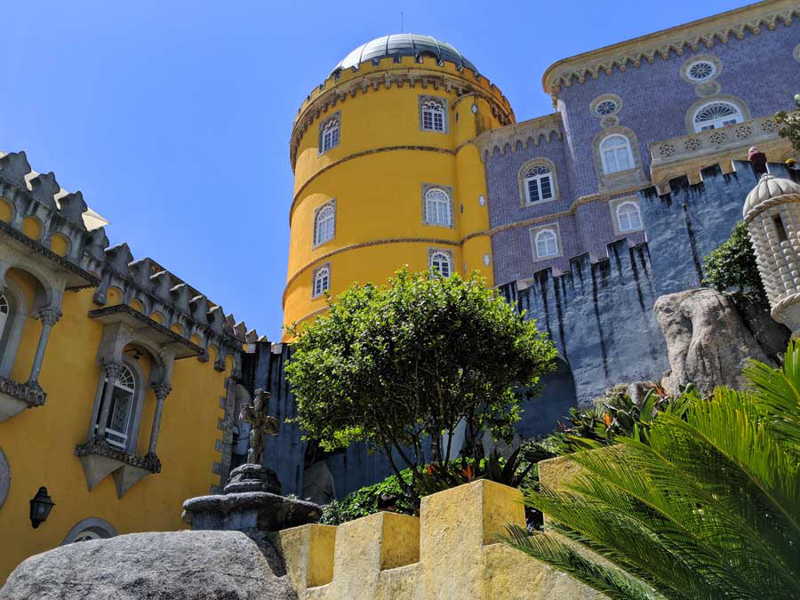
The UNESCO World Heritage site has a rich history that dates all the way back to the Middle Ages. Legend has it that it originally served as a religious chapel and monastery, which was built after an apparition of the Virgin Mary appeared in the area.
The monastery eventually fell into disrepair and ruins, but in the mid-1800s, Portugal’s king decided to acquire it and transform it into a summer palace for the royal family.
You can tour both the outside and interior of the palace. Considered one of Portugal’s top tourist attractions, this incredibly picturesque castle can get extremely crowded, particularly in the summer months and during peak hours.
To avoid the crowds and get the best photos of the palace without swarms of other people there, visit Pena Palace first thing in the morning.
PRO TIP: While most people tour the palace on a day trip to Sintra from Lisbon, if you stay the night in Sintra you will be able to visit the palace and experience this charming village without the crowds.
Text and photo by Melissa from Parenthood and Passports
Buckingham Palace, England
The official royal residence of the British monarchs and the administrative headquarters of the monarch, Buckingham Palace needs no introduction: it is one of the most iconic buildings on the planet and a must-visit on any London itinerary.
Buckingham Palace is grand. It features 775 rooms! Don’t miss the Grand Staircase with its red carpet, the Throne Room, with Queen Victoria’s throne, the Silk Tapestry Room with its fabulous artwork, and the enormous ball room.
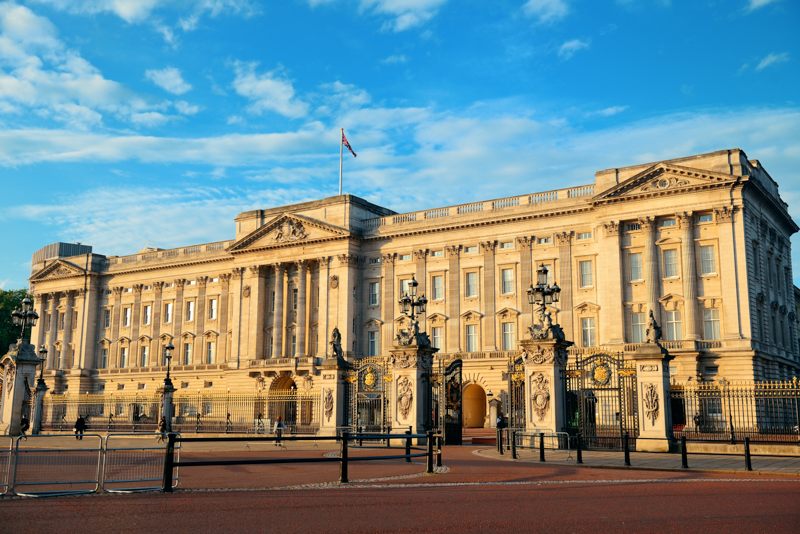
The balcony of Buckingham Palace is famous: you’ve likely watched on TV as the royals appeared on the balcony and waved. Queen Victoria started the tradition in 1851, and since then, balcony appearances have marked significant events in Britain.
Did you know that there are secret tunnels that run beneath Buckingham Palace? And the gardens are worth strolling as well, with flower beds and water features, and vast expanses of green.
The palace itself is a small city, with its own post office, pool, police station, cinema, health clinic, and other services.
The best time to visit the palace is during summer, when you can enter the staterooms since the Queen is away.
If you don’t wish to go in, you can enjoy the very popular changing of the guard ceremony outside Buckingham Palace at 10.45 am. Schedules vary, so check online before you go.
The best way to reach the palace is by using the Underground metro or bus. The closest metro stations are Green Park, Hyde Park Corner, and Victoria. If you prefer the bus instead, take bus number 11, 221, C1, or C10 to Buckingham Palace Road.
Text by Nisha from Nerdy Footsteps
Fredriksborg Castle, Denmark
Frederiksborg Castle is a beautiful rust-colored castle located in Hillerød, just outside Copenhagen in Denmark. Upon arrival, visitors encounter a set of gates and courtyards before crossing a drawbridge to access the islets upon which the castle and gardens sit.
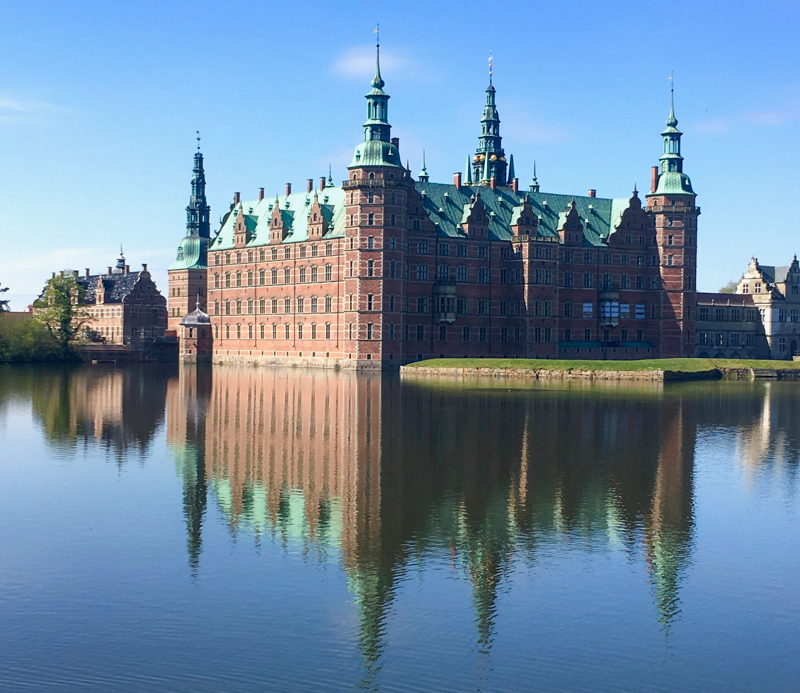
Constructed with red brick and towering spires in the 17th century, Frederiksborg is the largest Renaissance castle in the Nordics. The inside of the castle is adorned with elegant furnishings, high ceilings and large windows looking out onto the gardens.
The castle also houses The National Museum of History, which illustrates 500 years of Danish history with portraits, paintings, sculptures and more.
While the inside is undoubtedly impressive, the outside of the palace is just as grand. The property is covered in symmetrical, expansive gardens.
At the foot of the castle is Castle Lake. A walk around the lake is perfect for early morning walks with a cup of coffee in hand.
The easiest way to reach the castle is to take the train from central station in Copenhagen to the town of Hillerød (40 minutes) and then walk to the castle (25 minutes).
The castle is open year round, but the best time to visit the gardens is between late spring and early autumn. There is a fee to enter and tour the castle itself, but there is no charge to explore the gardens.
PRO TIP: Walk the path around Castle Lake. Here is an excellent place to photograph the reflection of the castle in the water. By going in the morning or early evening you will avoid the glare of the sun of the water.
Text and photo by Mikaela from Voyageur Tripper
READ MORE: How to Spend One Perfect Day in Copenhagen, Denmark!
Palais Royal de Bruxelles, Belgium
Each year, when Belgium celebrates its Independence Day on July 21, the royal family also observes a long tradition of opening up the Royal Palace of Brussels.
The Royal Palace of Brussels is the King and Queen’s administrative residence. The Belgian monarchy uses this glorious place as an office on a daily basis. And occasionally, state visits, royal news conferences, and other special events are hosted here.
But when the royal family goes on summer vacation after the Independence Day celebration, this gorgeous royal office is open to the public until their return in early September.
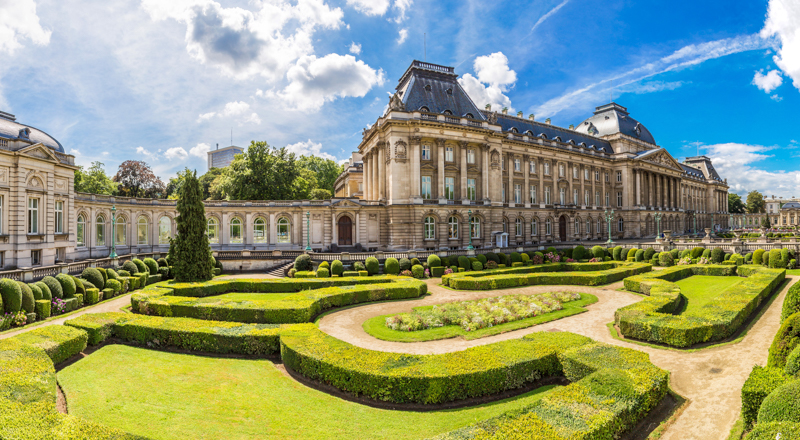
Located on the Parc de Bruxelles, the 19th-century palace features a beautiful neoclassical exterior and a well-manicured royal garden. The dazzling decorations inside, from the white marble stairway to mesmerizing crystal chandeliers to golden moldings, are enough to drop your jaw.
The most impressive room is the Mirror Room. This eclectic room is like no other typical European palace. The Heaven of Delight chandelier with green jewel beetles is crème de la crème in this classic yet modern space.
The best part of visiting the Royal Place of Brussels is that the crowd in the summer peak season is much more manageable than at other palaces of Europe. So don’t miss the limited opportunity to discover this hidden gem when you visit Brussels in summer.
PRO TIP: Visit early or late in the day for fewer crowds and a more enjoyable visit. And if you visit Brussels outside of summer, it’s still worthwhile peeking at the palace from outside!
Text by Chloe from Chloe’s Travelogue
Drottningholm Palace, Sweden
Drottningholm Palace, located on the outskirts of Stockholm, can be visited on a day trip from the Swedish capital. In fact, exploring Drottningholm Palace is one of the top things to do in Stockholm.
The private residence of the Swedish royals, Drottningholm Palace is modeled after Versailles, and is the best-preserved 16th century palace in the country. Aside from the main palace, the complex is also home to the Drottningholm Palace Theater and the Chinese Pavilion.
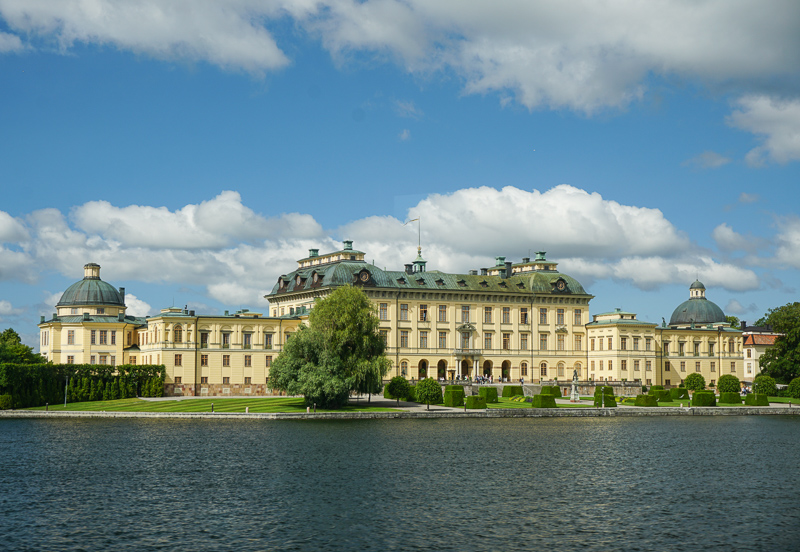
Inside the main palace, tour the grand reception rooms, with their ornate ceilings, excellent artwork, and elegant furnishings. The Royal Chapel is beautiful, and Queen Hedvig Eleonora’s State Bedchamber, where she actually received guests, is stunning.
Walk through the beautiful Baroque gardens with their elegant statuary and fountains into Drottningholm Park, a vast green space laid out in English park style with a maze, tree-lined avenues, and green meadows.
Visit the pink Chinese Pavilion, a gift from King Adolf Fredrick to his wife, Queen Lovisa Ulrika. The summer palace houses an extensive collection of Chinese porcelain, lacquer screens, and other Chinese art.
Visit Drottningholm Palace from Stockholm by ferry (in season) to get great photos of the palace as you approach from the water. You can also take the subway to Brommaplan and a bus from Brommaplan to the palace.
Visit from late spring to early fall to enjoy the grounds and the gardens and to travel to the island by ferry.
PRO TIP: Join a guided tour of the theater, where you can hear the sound of thunder created by the original mechanical machinery from the 18th century, and see the costumes used in productions from that time.
Suggested by us
Palácio da Bolsa, Portugal
The Palácio da Bolsa (also known as the Stock Exchange Palace) is a grand neoclassical historical building situated in the center of Porto.
The palace was constructed in 1842 by the city’s Commercial Association after the Queen of Portugal donated the land. The cloisters of the 13th century Saint Francis Convent stood at the site before they were destroyed in a fire in 1832.
Inside is a grand central courtyard, called the Courtyard of the Nations, enveloped by a glass edifice that allows natural light to penetrate the entire palace. There are staircases of stately marble and granite, and awe-inspiring ceiling frescoes throughout.

However, the undisputed highlight of the Palácio da Bolsa is undoubtedly the Arab Room, a 300-meter space finished in the exotic Moorish Revival style where most of Porto’s official receptions are still held today.
The creation of this symbolic area, by Gustavo Adolfo Gonçalves e Sousa, took over 18 years to realize, and when you visit, you can see why. The level of detail and craftsmanship is almost incomprehensible and ensures the Palácio da Bolsa will remain one of the prettiest palaces in Europe now and forever.
One of the most unique places in Porto, the palace is walking distance from most of the city center hotels.
PRO TIP: Don’t skip the guided tour or you risk missing most of the intricate details that make visiting Palácio da Bolsa so unique. The tours are available in four languages, but you can snag a spot on a tour in English if you arrive early, before the tour buses.
Text and photo by Jordan from Inspired by Maps
Neuschwanstein Castle, Germany
If you want to visit one of the most picturesque castles in Germany, you should definitely make the journey to Neuschwanstein Castle in Bavaria, in the south of the country.
Neuschwanstein Castle is one of the most popular tourist destinations in the world and even inspired Walt Disney’s own Magic Kingdom castle. It truly looks like a fairy tale castle!
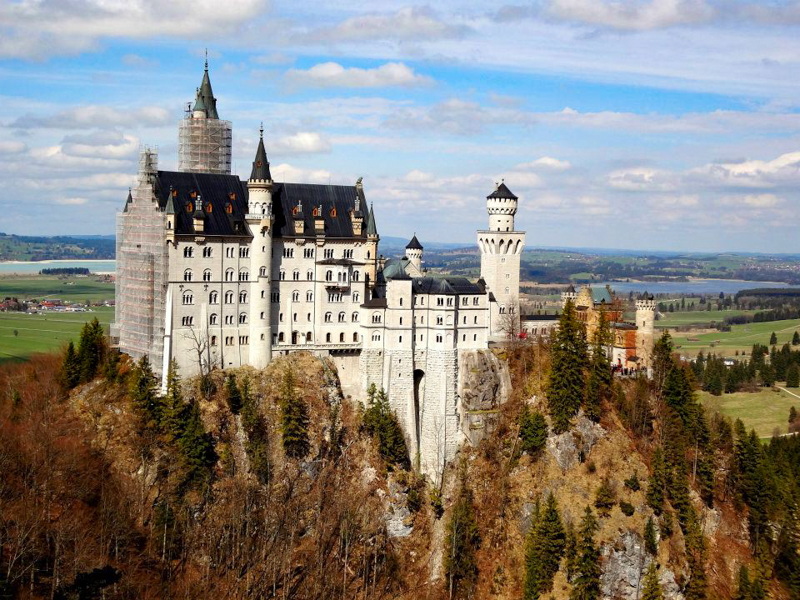
Older than it looks, Neuschwanstein Castle is technically not finished. However, the building was originally started in 1869 by King Ludwig II of Bavaria and has been open to the public since 1886. Set on top of a hill, Neuschwanstein overlooks the beautiful Hohenschwangau valley.
One of our suggestions would be to skip the inside tour of the castle and hike up to a fantastic viewing point at Marienbrücke (or Mary’s Bridge). We even recommend going further up the hill on the other side of Pollat gorge for an excellent view of the castle and valley.
The forests and hills surrounding the castle are also well worth the wander around if you have time.
Just 1 hour 40 minutes (or about 75 miles) outside of Munich near the town of Fussen, Neuschwanstein is easily accessible by car, public transportation (3+ hours) or by tour.
When planning your trip here, I suggest avoiding the crowds (and the heat) by going anytime other than July or August if at all possible.
PRO TIP: If you do really want to go inside the castle, be sure to book tickets well in advance and stay flexible, because you may not get your requested time. Remember, this is a popular destination, so lines are also very common.
Text and photo by Ashley from Impact Winder
Topkapi Palace, Turkey
Topkapi Palace is one of the most popular tourist attractions and a must-do in your Istanbul itinerary. Also known as Topkapi Sarayi (in Turkish), the palace name literally translates to ‘Cannon Gate Palace.’
The palace was once the preferred choice of residence for the Sultans of the Ottoman empire.
Sultan Mehmed II ordered the construction of this palace in 1459 and called it “New Palace” (Yani Saray). According to historians, the Sultan summoned the best masons, carpenters and stone cutters from different parts of the world to build this palace. The site served as the main administrative headquarters for the ruling Sultans.
The Topkapi Palace is an interesting place to visit as it is also a museum that houses relics that are a valuable part of Islamic history. The Palace contains an Imperial Gate, four beautiful courtyards, and several small buildings.
Aming the main attractions of the palace are the Imperial Treasury (contains the arms collection), Gate of Felicity, the palace kitchens, Audience Chamber, Grand Kiosk, and the Terrace Mosque.
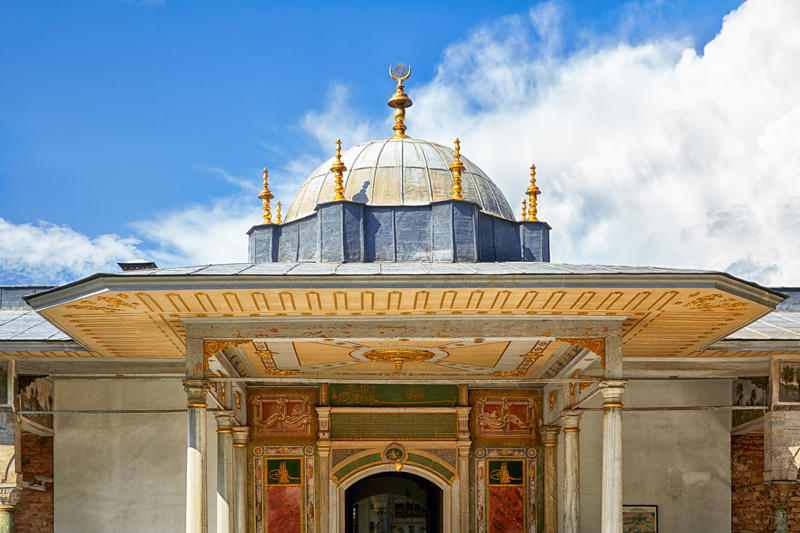
Some striking features of the palace are the marble pillars, ceilings decorated with gold, beautiful Iznik tiles, intricate wall paintings, and gilded grills at the entrance to every room.
The best part of the palace is the Grand Kiosk, from where you get a stunning panoramic view of the Bosphorus. It was also the resting place of the Sultans.
The Topkapi Palace is located in the Fatih district of Istanbul. To get to the palace, take a Funicular tram from Taksim Square metro station to Kabatas terminal. At the Kabatas terminal, change to Metro Tram T2. The metro takes you to all important tourist sites like Topkapi Palace, Sultanahmet, and Hagia Sophia.
The best times to visit the palace are Monday, Wednesday, and Thursday mornings. Avoid Fridays and the weekend due to prayers and excessive tourist crowds. The palace is closed on Tuesdays.
PRO TIP: Visit early to avoid huge tourist queues and use the Istanbul Museum Pass to save money!
Text by Vaibhav from The Wandering Vegetable
Oslo Royal Palace, Norway
Completed in 1849, Oslo’s Royal Palace is an unmissable stop on any Oslo itinerary and is still the official residence of the Norwegian royal family.
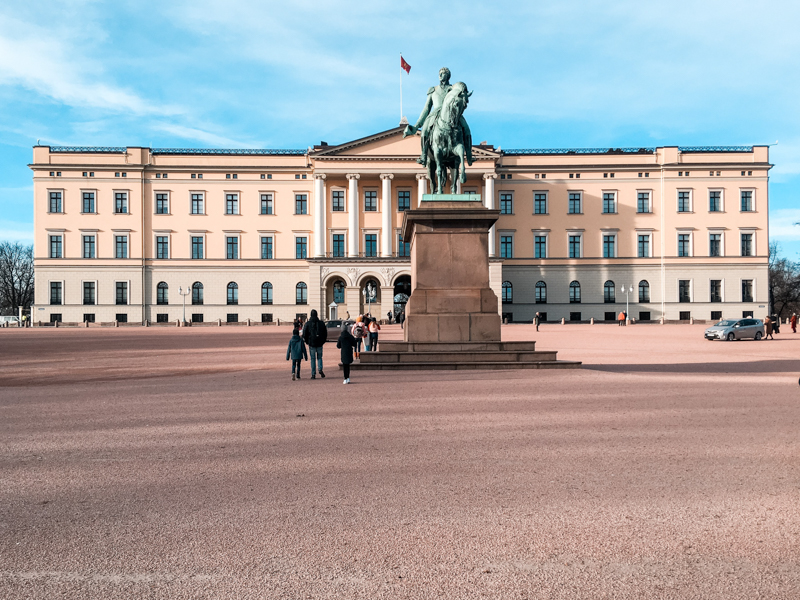
The most popular way to visit the palace is by attending the changing of the guard ceremony, which lasts around 40 minutes in total. The ceremony starts at 1:30 pm, and takes place every day.
To watch, walk up to the royal palace a few minutes beforehand and join the other waiting spectators. Even if you can’t make the changing of the guard ceremony, it’s worth heading over to the palace during your time in Oslo just to glimpse the beautiful building.
The palace is surrounded by the Palace Park, a protected cultural monument open to the public year-round. The park is a great place for a stroll.
Walking through the park and marveling at the palace, you’ll be pleasantly surprised by how relaxed visiting the palace feels in comparison to other European places. There are no gates or barriers between the palace and spectators, and visitors are free to wander (within reason).
The palace is located at Carl Johan’s Gate in central Oslo. The best way to get to the palace is on foot. From Oslo Central train station, the walk is approximately 20 minutes, and leads you past a number of Oslo’s famous landmarks.
The best time to visit the palace is in summer, when the palace runs guided tours for the public. Tours depart in Norwegian every 15-20 minutes between 10am and 5pm. English tours run multiple times per day.
PRO TIP: The guided tour of the palace lasts around one hour and is often fully booked, so it’s a good idea to buy tickets in advance.
Text and photo by Ella from Many More Maps
READ MORE: The Ultimate 10-Day Scandinavia Itinerary!
Château de Chambord, France
Any list of the prettiest palaces in Europe has to include at least one place from a destination well-known for its castles: the Loire Valley in France. The Château de Chambord is a must-visit if you plan a trip to the Loire Valley!
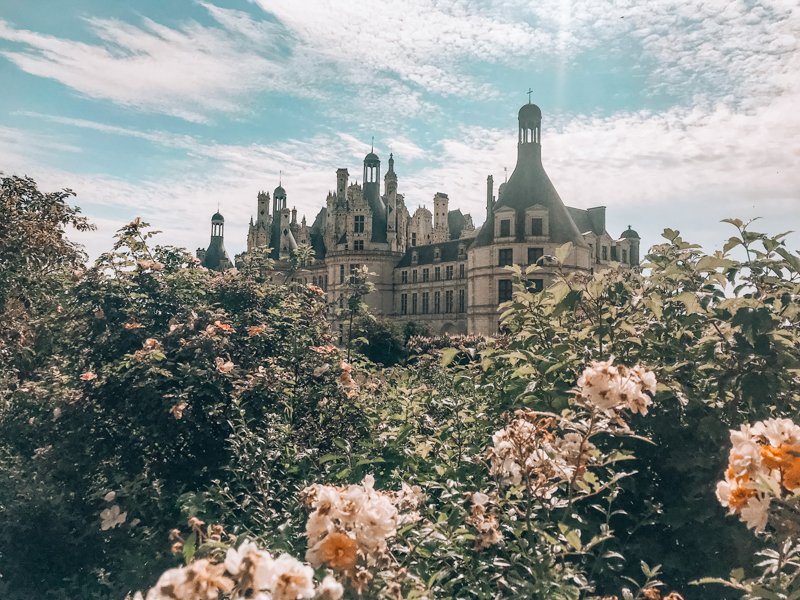
Not only is it the most visited château in the Loire Valley, but the Château de Chambord is famous for being the inspiration for Disney’s Beauty and the Beast. Its history dates back to the early 16th century, when Francois I, influenced by the work of Leonardo da Vinci, had Château de Chambord built as a hunting lodge.
He only ended up using it for two months during his reign and that’s it! This grand palace is quite large with over 400 intricately-designed rooms and 84 staircases, some of which are a piece of art on their own!
Every detail, from the opulent fireplaces within the rooms to the perfectly manicured gardens is truly dazzling. However, you’ll notice that many of the furnishings are no longer there. This is because during the French Revolution, the furnishings were sold and used to aid in the war.
The easiest way to get to Château de Chambord is by a group tour from Paris. It is the perfect day trip! However, you could also rent a car and drive two hours south.
Or take the train from the Paris Austerlitz station to Blois-Chambord (about 1 hour and 20 minutes) and take a bus from the station (the bus runs from April-November). You can also take a taxi from the station.
To beat the crowds and heat in this popular palace in France, you’ll want to go during the shoulder season, which is April-May or September-October. Also, arriving when it opens at 9 am is a great way to avoid crowds during the busy season in the summer.
PRO TIP: Be sure to take the time to walk the grounds! The gardens are stunning and there is so much space to walk around and enjoy this gorgeous French château!
Text and photo by Kat from Worldwide Honeymoon
Warsaw Royal Castle, Poland
The Royal Castle in Warsaw was originally built sometime in the 14th century as a residence for local monarchs. It was reconstructed many times in Polish history and entirely rebuilt in the 20th century after the events of the Second World War and the subsequent Warsaw Uprising (1944), which left only a small fragment of a wall standing.
The Royal Castle is located in the Castle Square, where you can also see Sigismund’s Column in the middle and St. John’s Cathedral looming over the square. The Castle Square serves as one of the main gateways to the picturesque Old Town.
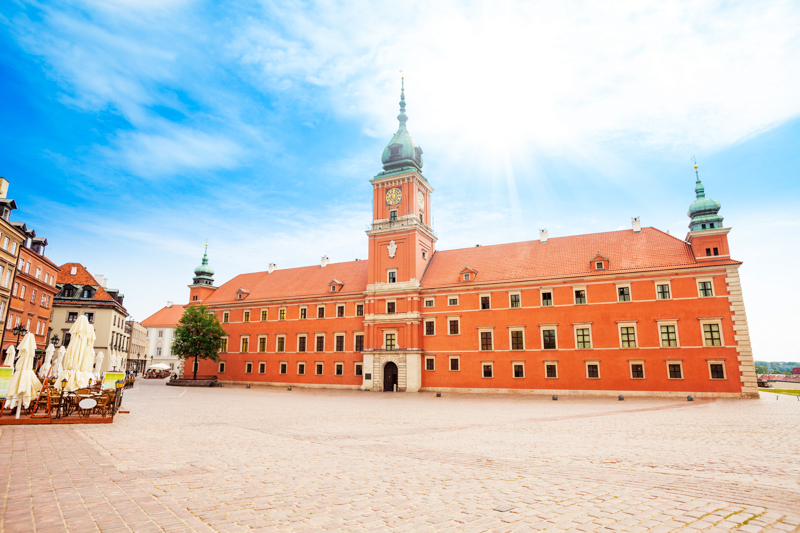
Climb the tower of St. Anna Church to get the best view of the Castle Square dominated by the vast brick Royal Castle.
The Royal Castle has been on the UNESCO World Heritage Site List since 1980, together with the masterfully rebuilt Old Town of Warsaw.
Nowadays, the Royal Castle houses a museum operated by the Ministry of Culture and National Heritage. State visits are often held there too. The museum mainly showcases the carefully rebuilt interiors of the castle, a couple of historical collections, as well as an exhibition of oriental carpets and decorative art.
To get to the Royal Castle, get off at a bus/tram stop called Plac Zamkowy (Castle Square) or Stare Miasto (The Old Town). The entrance is paid, except on Wednesdays. You can either just pay for an entrance or choose to properly visit the Castle with an audio guide or a live guide.
The Castle is just one of many reasons to visit Warsaw. Strolling through the Old Town is a joy!
Text and photo by Veronika from Travel Geekery
Château d’Amboise, France
Chateau d’Amboise sits high above the river in the Loire Valley of France. A castle has sat on this site since the 900s, with improvements being made over time.
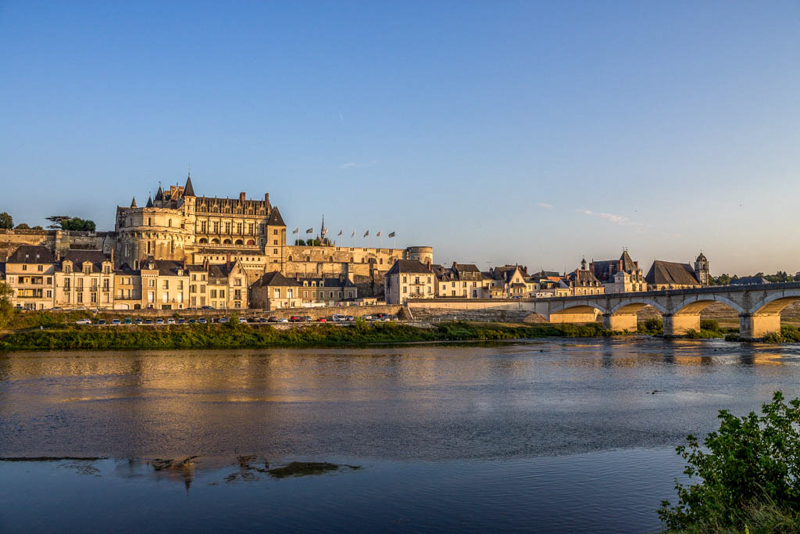
Perhaps one of its more interesting contributions to history is being a royal residence to French monarchs, starting with Charles VII. While many kings were raised at Château Amboise, another famous name to grace the halls is Leonardo da Vinci. A guest of King Francis I, from 1515 da Vinci lived in a nearby château that was connected to the palace by an underground tunnel.
Amboise fell into disuse by royals after something known as the Amboise Conspiracy, a plot to kidnap the king. It’s one of the main events that led up to the French Wars of Religion.
The most impressive thing about Chateau Amboise is its dominating presence over the town of Amboise. The large Gothic palace is adorned with multiple towers and built from the white stone and blue tiles that characterize castles in the Loire Valley.
The best time to visit Chateau d’Amboise is in the spring or fall when the weather is pleasant and there are fewer tourists.
A car is the best way to visit as it will allow you to explore around the Loire Valley. Joining a day trip from Paris is also a popular way to visit Amboise.
PRO TIP: To get the best views of the palace over the Loire River with the bridge in the photo, cross the bridge and walk alongside the shore in either direction. There are trails and small parks perfect for getting the ideal vantage point.
Text and photo by Brianna from Curious Travel Bug
Buda Castle, Hungary
Settled on Castle Hill (Várhegy) above the Danube River, Buda Castle, also known in the past as the Royal Palace, looks awe-inspiring.
You can’t miss this historical beauty as it adorns the city’s skyline. Visiting Buda Castle is undoubtedly is one of the best things to do in Budapest.
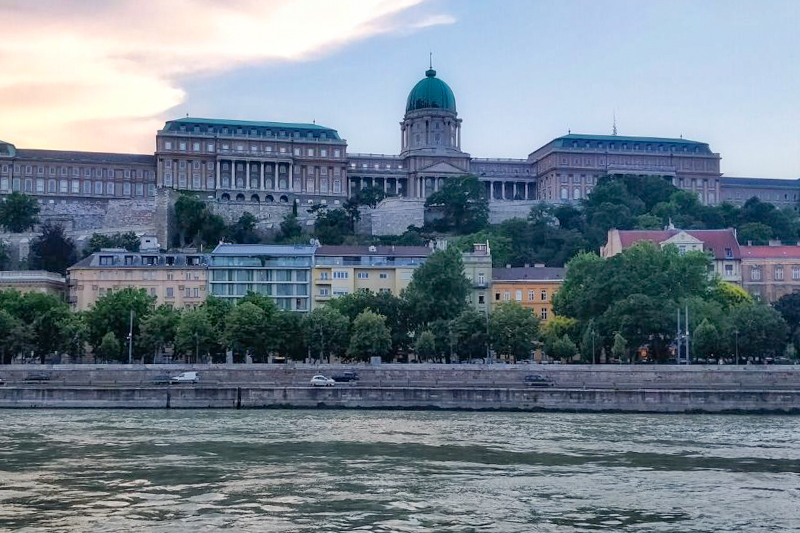
The former royal residence of Hungarian kings and a part of Budapest’s UNESCO World Heritage Site, the castle has a turbulent history. It has been built, destroyed, rebuilt, and restored many a time. The medieval remnants can still be seen if you visit the Mace Tower (Buzogánytorony) near the castle’s Ferdinand Gate.
St. George’s Square, home to the Sándor Palace, office, and the official residence of the President of Hungary, mark the entrance of Buda Castle. A well-adorned gate with Hapsburg’s steps leads you down to the castle area.
Today, the castle houses the Hungarian National Gallery, the Budapest History Museum, the National Széchényi Library, and other beautiful attractions like Lions’ Gate & Courtyard, Matthias Well, Fishing Children Fountain, and statues of Prince Eugene of Savoy, King Matthias, Turul Bird, and Magyars.
The iconic feature of the castle is the eagle’s eye views over Buda, Pest cityscape, and the River Danube, along with its classic bridges, from the dome terrace. You can access this iconic vantage point with an admission ticket to the National Gallery of Fine Arts.
You can walk the stairs from Chain Bridge at Clark Adam Square or walk uphill along the funicular path to reach the castle. The easiest way to get to the castle, of course, is taking the Buda Hill Funicular that operates from 7:30 am to 10 pm.
The best time to visit Buda Castle depends upon what exactly you expect out of your visit. If you’re keen to check out the views over the city from the dome terrace, then you’ll have to visit between 10 am to 6 pm from Tuesday to Sunday.
If you’d love to enjoy the sunset or sunrise over the Danube from the castle’s courtyard fence, plan to visit during early dawn or dusk. The courts and courtyards are open 24X7 day in, day out.
PRO TIP: Take the funicular up to the Buda Castle and walk back down to enjoy both perspectives. Also, take a Danube Evening Cruise to admire the castle from the water after dark, as it looks breathtaking when lit up.
Text and photo by Anjali from Travel Melodies
Stockholm Royal Palace, Sweden
The Stockholm Palace or the Royal Palace of Stockholm in Sweden is the official residence and major royal palace of the Swedish Monarch.
The location of the palace has been in the same northern part of Gamla Stan in Stockholm since the middle of the 13th century, but the exact building has been around since the early 18th century and is one of the largest palaces in Europe to date.
The Royal Palace contains 600 rooms spread across 11 floors. The Royal Apartments are a major draw, as each of the rooms is ornately decorated from top to bottom with finishes dating back to the 18th and 19th centuries. Some highlights within the Apartments include Gustav III’s state bed chamber, Oskar II’s writing room, and Queen Christina’s silver throne in The Hall of State.
Beyond the Royal Apartments you’ll find the Treasury, with its extensive collection of regalia and precious objects. The Museum Three Crowns tells the story of the original Tre Kronor Palace’s development. The Royal Chapel, with its beautiful ceiling, is a must-visit.
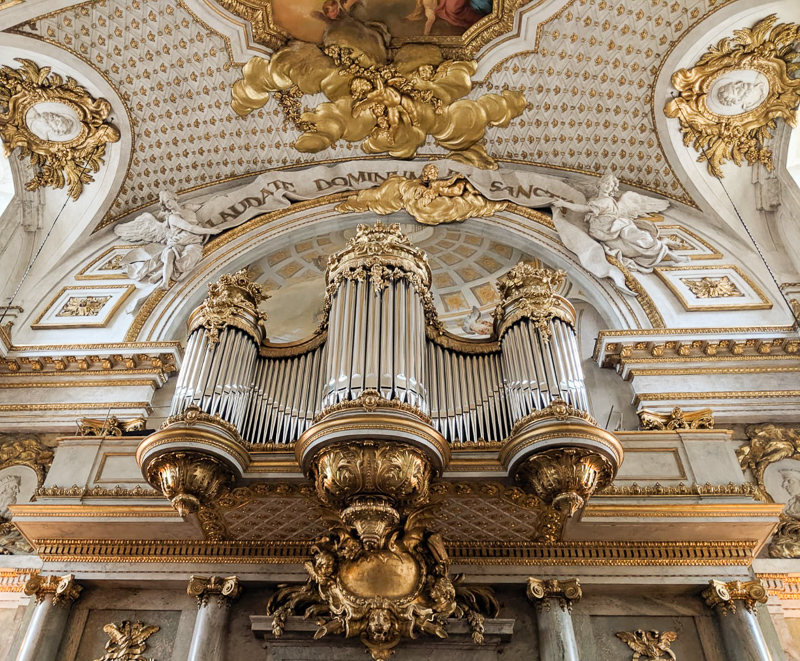
The Royal Palace is located in the middle of Stockholm, reachable from many areas on foot. But if you are traveling by subway, the nearest station is Gamla Stan, served by the red and green line, or the Kungsträdgården station, on the blue line.
PRO TIP: The best time to visit the Royal Palace is during the daily changing of the guard at 11:00 am, when a full ceremony, with marching band and parade of soldiers takes place. The palace is closed on Mondays.
Text by Mona from Mona Corona
READ MORE: The Ultimate Itinerary for One Day in Stockholm!
Peleș Castle, Romania
Romania’s Peles Castle is undoubtedly one of the most beautiful palaces in Europe. The palace is nestled in the Bucegi Mountains, surrounded by lush greenery, gardens, and views for miles.
Peles Castle was built in 1883 by King Carol of the Romanian royal family. The Castle was well ahead of its time when it was built. It was the first European castle to have electricity, as well as other advanced amenities for the time, like central heat and central vacuum, and even an elevator.
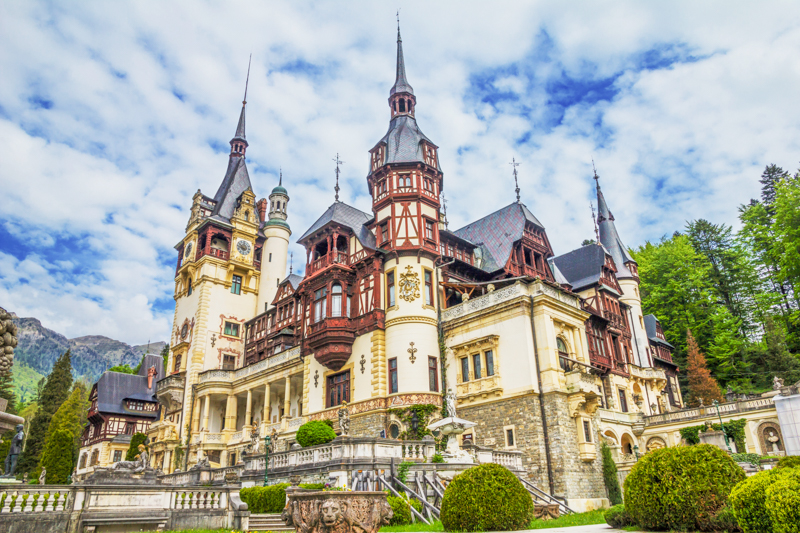
Peles Castle is home to 160 rooms that range from a music room to a library with a secret door, and even a theater, where Romania’s first film was shown in 1906.
What makes this place so grand is the attention to detail, from the frescoes painted inside and outside to each and every room having its own distinct design. You’ll find stunning stained-glass windows, leather-covered walls, and Murano crystal.
Visiting the Romanian capital? One of the best things to do in Bucharest is a day trip to Peles Castle, with either a tour company, or by taking the train or bus to Sinaia, a journey of approximately 2.5 to 3 hours.
Any time of year is great to visit Peles Caste, but visiting in the late spring helps with fewer crowds and still offers you stunning lush surroundings.
PRO TIP: One thing to note is that a photography pass must be purchased along with admission if you plan to take photos within the building. And you’ll want to get that pass!
Text by Stephanie from Lady’s Travel Blog
Blenheim Palace, England
If you are planning a trip to England, then you should definitely visit Blenheim Palace, the main residence of the Dukes of Marlborough.
Blenheim Palace is a beautiful and really huge estate located in Woodstock, Oxfordshire. It is known as the only building in England that bears the name of ‘palace,’ while not being owned by royal authority or church.
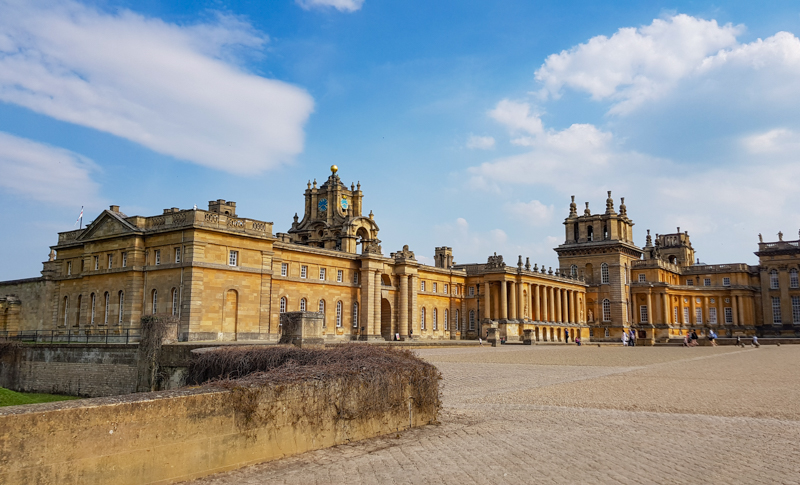
The palace was built in the 18th century (between 1705 and 1722) and it was a gift from the queen to John Churchill. According to the historians, it was a prize for winning over the French army at the Battle of Blenheim in 1704. The future Prime Minister of Great Britain Winston Churchill was born here in 1874.
Designed by John Vanbrugh, one of England’s most famous architects, the English Baroque architecture of Blenheim was a subject of some controversy when it was being built.
Public state apartments inside the palace have ornate ceilings and wall murals. The Long Library at Blenheim houses the largest privately-owned pipe organ in all of Europe.
The building is surrounded by a park, woodlands, and formal gardens with beautiful water features, and the palace and the gardens are actually connected by a mini train, the Blenheim Park Railway.
In 1987, Blenheim Palace and its gardens were inscribed on the famous UNESCO World Heritage list. Today the building is one of the biggest tourist attractions in the area and an extremely popular destination for a day trip from London.
You can either drive to Blenheim Palace, or if you want to visit from London by public transport, take a train to Oxford and then the bus to Woodstock/Blenheim.
The best time to visit is during the warm summer months, when the gardens and grounds are at their best.
PRO TIP: If you only want to walk in the green areas around the palace, you can do so for free.
Text and photo by Darek from Darek and Gosia
Augustusburg Palace, Germany
The Augustusburg Palace was built in the 18th century, as the residence of Clemens August of Bavaria. Together with the Falkenlust Palace, the Augustusburg Palace is designated a UNESCO World Heritage Site.
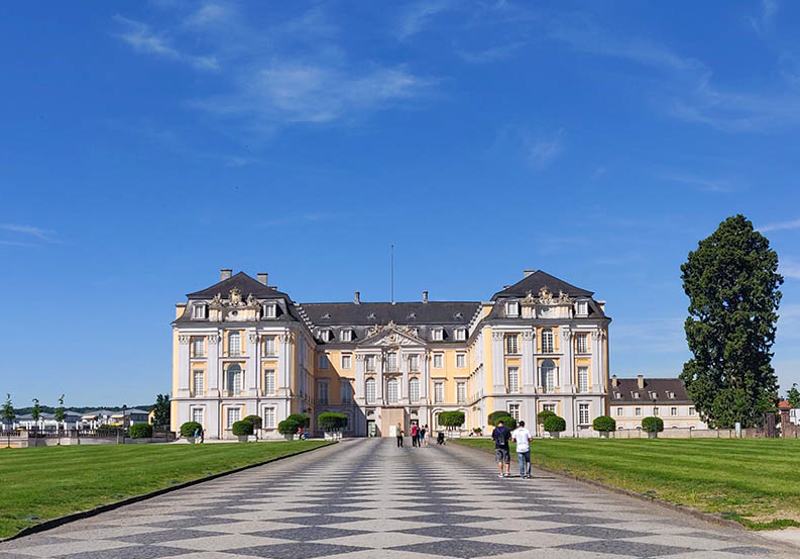
The palace is considered one of the best examples of the Rococo style in Germany. It is exceptionally decorated, with frescoes in soft, pastel colors. From a room with wallpaper of gilded leather, to a grand staircase, to marbled patterns on pillars, there are so many aspects of the palace that would mesmerize anyone!
The palace gardens are huge, with water features and flower beds. The gardens are accessible free of cost.
Located just a little over one mile from Augustusburg Palace, through the garden, is the Falkenlust Hunting Lodge. The lodge is much smaller, but as exquisite in terms of art, as the palace. Falconry symbolism is prominent in the lodge.
While just Augustusburg and its gardens can be seen one a half-day trip, it would take almost an entire day to see Falkenlust as well.
Both palaces are closed throughout December and January. The best time to visit would definitely be in the spring, when the gardens are in full bloom.
The palaces are located in Brühl, on the outskirts of Cologne, and can be easily reached by train in just 20 minutes. The Augustusburg Palace is just a 2-minute walk from the railway station.
Text and photo by Bhushavali from My Travelogue
Palais des Papes, France
Avignon’s Palais des Papes is the most iconic building in the UNESCO-listed old town. It rises proudly above the terracotta rooftops of the well-maintained townhouses that surround it and forms the backdrop to the café terraces that spill out onto the Place du Palais.
The palace was constructed in the 14th century under the rule of Pope Benedict XII, but many successive Popes also left their mark on the palace, by extending or adding to the original building. Avignon didn’t remain the Papal Capital for long, but the palace remained in the hands of the church until the French Revolution in the 18th century.
These days, the Palace is open for the public to enjoy (a fee is payable), and a visit to the halls and rooms of the intricate interior is one of the most popular things to do in Avignon.
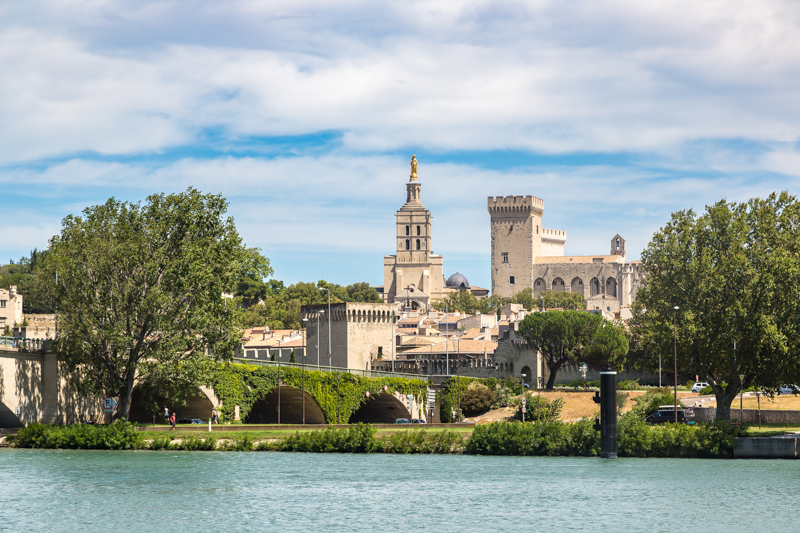
Grab a histopad near the reception to take a self-guided tour in your native language. As you tour the rooms, many will be transformed 3D-style into their former glory on the screen, so you can see how the Popes once lived.
The tour is divided into two parts, each taking roughly half an hour. Afterwards, be sure to make your way up to the roof terrace, which will afford you fabulous views over the city and the River Rhône below. There’s even a small café to grab a drink or bite to eat while you’re enjoying the views.
To get to the palace, park at one of the public lots outside the ancient city walls and proceed on foot. Simply follow the signs that are peppered throughout the town.
Visit during the week in the shoulder season for the best experience and to avoid the overwhelming summer crowds.
PRO TIP: For the best deal, purchase a combined ticket to visit the Pont d’Avignon and the Pope’s Palace in the same day.
Text by Nadine from Le Long Weekend
Palacio Real de Madrid, Spain
The Royal Palace of Madrid (Palacio Real de Madrid) is the official residence of the Spanish royal family, but today it is used only for state ceremonies. With 145,000 square feet of space spread over 3,418 rooms, it’s the largest functioning royal palace in Europe.
Visiting the Royal Palace is a must on any Madrid itinerary!
The royal palace was originally founded on its current site between 860 and 880. Over time, many renovations were made to the original building, but due to an extensive fire in 1734, it was completely destroyed.
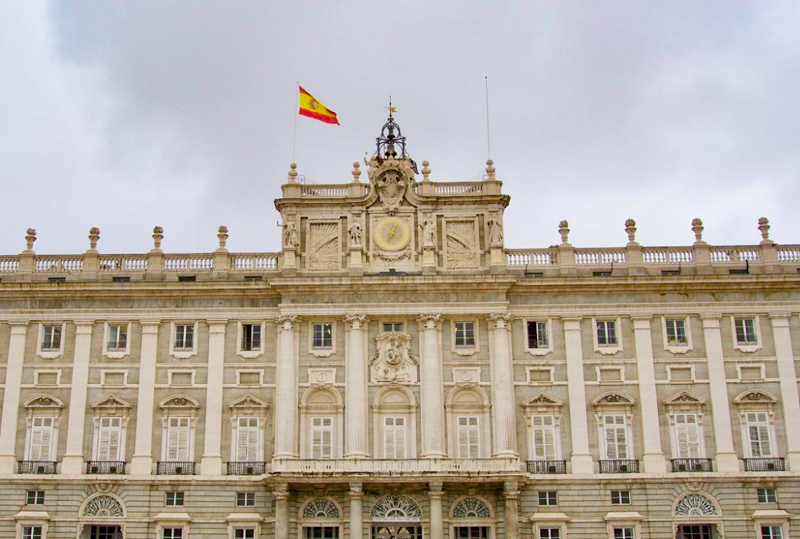
The palace was rebuilt during the mid 1700s with designs inspired by the French Palace of Versailles. The palace would continue to be enlarged and renovated for the next 100 years. The final residing monarchs spent a considerable amount of time and money decorating the palace, making it well worth the price of admission.
Today, visitors can enjoy the beautiful palace building, the lavishly decorated rooms, and the extensive collection of artwork housed here. Among the most famous artworks are those by Goya, Caravaggio, and Velazquez.
The entrance hall and staircase, where visitors begin their tour, is especially stunning, with its elaborately decorated ceiling. Outside the palace is the Plaza de la Armeria. Don’t leave before enjoying the views of the countryside from the Plaza.
Visitors can opt for a guided tour, or explore on their own. The palace is located in downtown Madrid near many other popular attractions. It is close to metro stations, and there are also several nearby train and bus stops.
Visit in the late fall, early spring, or winter, for the best experience. Summer brings high temperatures, and the changing of the guard ceremony may be canceled due to the heat.
PRO TIP: The Royal Palace is one of most popular sites in Madrid, so it’s recommended to arrive early.
Text and photo by Wendy from Empty Nesters Hit the Road
READ MORE: The Ultimate 2-Week Itinerary for Andalusia, Spain!
Palazzo dei NormanNi, Italy
The Palace of the Normans is the oldest royal residence in Europe, dating from 1130 AD. Don’t confuse it with La Cuba, another Norman-era palace about a 15-minute walk away, that is also worth visiting while you’re in Palermo.
The first palace at the location of the Norman Palace was built by the Arabs, in the 9th century. When the Normans invaded Sicily two centuries later, they transformed the palace into their own seat of power as well as their royal residence.
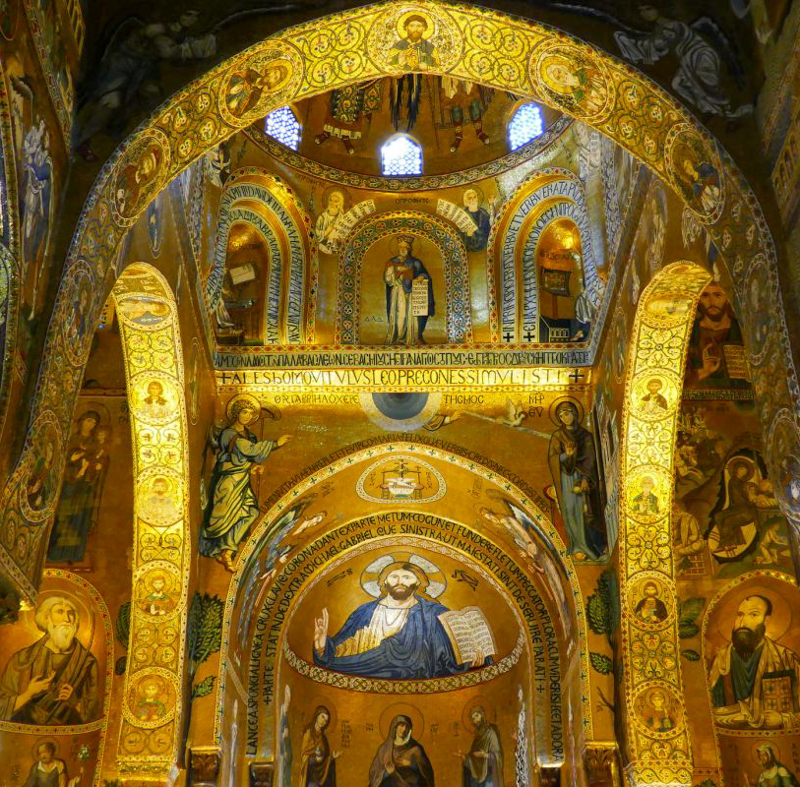
Imposing crenellations on the fortified exterior walls belie the delicate beauty of the Arabesque interior decoration. The undisputed highlight is the dazzling interior of the Palace Chapel, which is completely covered with Byzantine-style mosaics. If you’ve been inside St. Mark’s Basilica in Venice, or the Hagia Sophia in Istanbul, the style will be very familiar to you.
The Palazzo dei Normanii is located right in the city center of Palermo, which is connected by rail and air to other cities in Sicily and mainland Italy.
A combined ticket to the Palace Chapel and the royal apartments is available. Tickets can be purchased online for an additional booking fee, and you will need to specify a time slot when purchasing the tickets.
Even though the palace doesn’t draw crowds as big as some other sights in Italy, it’s still best to take the first time slot at 8:30 am, so that you can enjoy the incredible architecture in peace and quiet.
PRO TIP: Once you’ve finished exploring the palace, take the short walk to the boisterous Ballaró market. Be sure to sample Palermo’s famous panelle, a naturally vegan Italian street food made from chickpea flour.
Text and photo by Wendy from the Nomadic Vegan
Catherine Palace, Russia
Catherine Palace, south of St. Petersburg in Russia, was originally built as a summer palace for Catherine I. That palace lasted a short time before it was torn down and replaced with the current palace by Empress Elizabeth.
When the palace was inherited by Catherine the Great, she toned down some of the more ostentatious elements, like the olive colored figures and gold decorations along the façade.
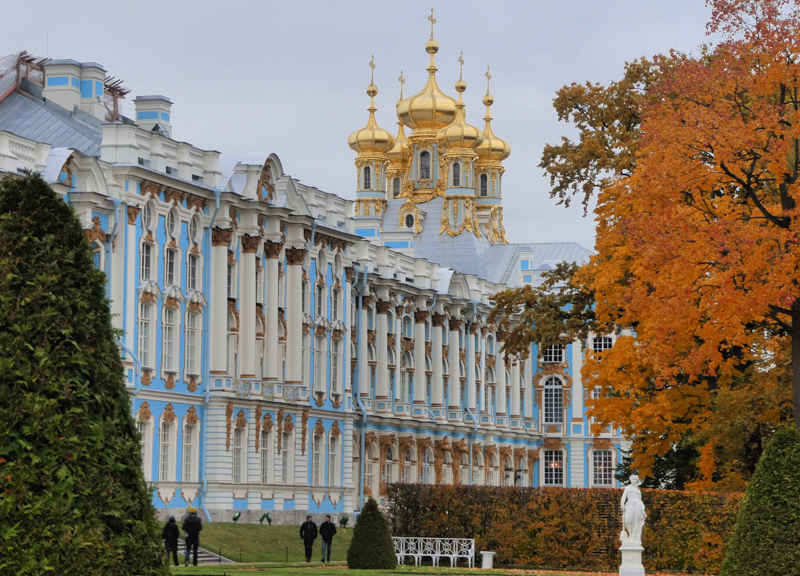
The two most famous rooms in the palace are probably the Amber Room and the Great Hall. The original Amber Room was looted during the WWII and it’s not certain whether it survived. Visitors today see a reconstructed version that took decades of work by Russian craftsmen to create. This is the only part of the palace where you aren’t allowed to take photos.
The Great Hall is awash with gold leaf, windows and mirrors. The ceiling is one enormous painting and the floor is a beautiful layout of different colored woods. One can only imagine what it would have been like to attend an event here during the palace’s heyday.
Sadly, at the end of the siege of Leningrad in World War II, the retreating German forces deliberately destroyed the palace. Today you see a restoration of how it’s believed the palace looked based on Soviet archive documentation. Restoration work is ongoing and additional rooms continue to be restored and opened to visitors.
As the palace is an indoor attraction, any time of year is a good time to visit. However, if you want to enjoy the gardens, or see the trees turn the most beautiful gold color, then summer or fall are perfect times to visit.
The palace is about an hour south of St. Petersburg by public transport or a 45-minute drive in your own vehicle. It is also widely included on many organized tours of St. Petersburg.
Text and photo by Lee and Stacey from One Trip At A Time
Château de Fontainebleau, France
The Château of Fontainebleau is one of the best castles near Paris you can visit. It is also one of the largest royal châteaux in France.
The Château de Fontainebleau is often compared to its neighbor Château de Versailles, also a royal castle. The truth is that Fontainebleau’s history is much more interesting: from Louis VII in the XII century to Napoleon, Château de Fontainebleau has hosted all the kings, queens, and emperors of France!
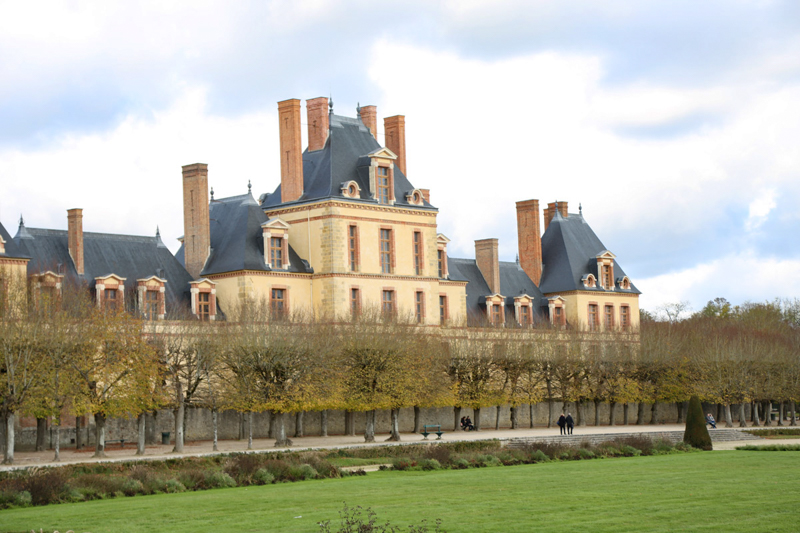
Fontainebleau is well known for the forest of the same name: the largest forest of the region, and one of the best places for hunting in France. The first castle, a kind of keep surrounded by walls, was built in the XII century as a hunting place for King Louis VII.
The king’s successors spent a lot of energy and money enlarging and rebuilding this castle with the latest architectural trends, and today Fontainebleau is one of the largest and most beautiful castles in France. Today, visitors can see a building mix of different architectural styles.
Inside, there’s a succession of rooms, grand halls, and more rooms. Sometimes it is difficult to understand the purpose of each room because the furniture is not the original. Still, the decoration is stunning and the information panels are very helpful.
The gardens are also an important part of the ensemble, again representing the major landscaping styles of different periods. The Grand Parterre, the largest in Europe and King Louis XIV’s main intervention in Fontainebleau, is outstanding.
The best time to visit Fontainebleau is in October or November, for fabulous fall colors in the forest and lesser crowds.
Trains to Fontainebleau leave from Paris Gare de Lyon, and the ride takes about 40 minutes. At Fontainebleau train station, there’s a bus shuttle that takes visitors to the castle.
Text and photo by Elisa from World in Paris
Munich Royal Residenz, Germany
The Munich Royal Residenz is one of the most visited attractions in Germany. One of the prettiest palaces in Europe, it should be a must-visit on your Munich itinerary.
Formerly known as Neuveste, the complex was built as a small retreat from the local rebellions in 1358. It is surrounded by wide moats.
When the lower and upper parts of Bavaria were united, the Munich Royal Residenz became the residence of the royal Wittelsbachs family, the rulers of Bavaria for many centuries. The Munich Residenz was their official home for over 700 years. This long duration of ownership is the reason for the grandeur of this castle, as the Residenz was maintained and continually expanded.
The Residenz was considered the largest and the most luxurious Renaissance castle in the whole of Europe. The elegance and luxury of Residenz are evident from some of the famous sections. The beautiful Antiquarium Hall is home to Bavarian antiques and sculptures. The Royal treasury has extensive collections of royal jewels.
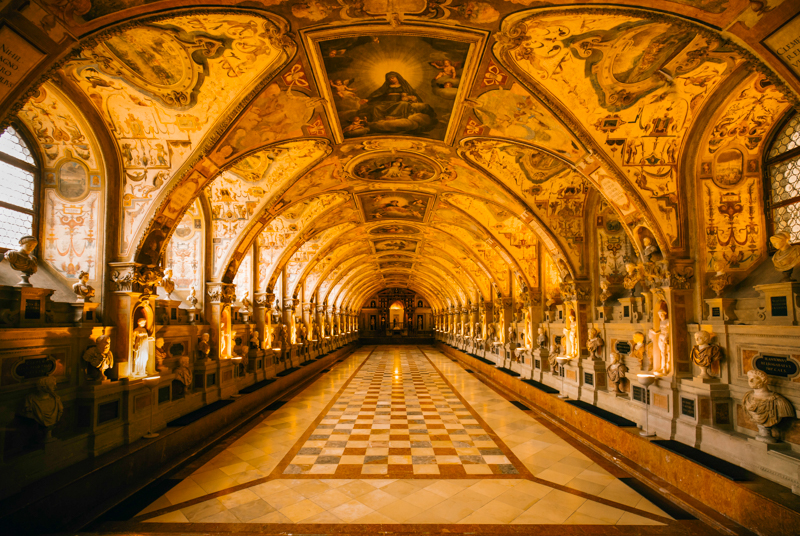
Admire the enormous marble Stone Rooms built exclusively for the Holy Roman Emperor, and the Ornate Rooms richly decorated with antique furniture. Gawk at the hundreds of murals, the medieval fountains Medusa and shell, and the Ancestral Gallery. Enjoy a walk in the Winter Garden.
The Munich Royal Residenz is located in the old town, within walking distance from Marienplatz, which can be reached by subway. The best time to visit the Residenz is early mornings or evenings.
PRO TIP: Buy the Bavaria Castle Pass if you are planning to travel in this region, as you can visit other palaces with the pass.
Text and photo by Reshma from The Solo Globetrotter
Palazzo Pitti, Italy
The 15th century Palazzo Pitti (or Pitti Palace) is a magnificent structure in the historic center of Florence, the Renaissance seat of Italy.
Today, touring the Palace should be part of any Florence itinerary whether you have one day or a week. Movie buffs will recognize it from appearances in many flicks, including Tom Hanks’ Inferno.
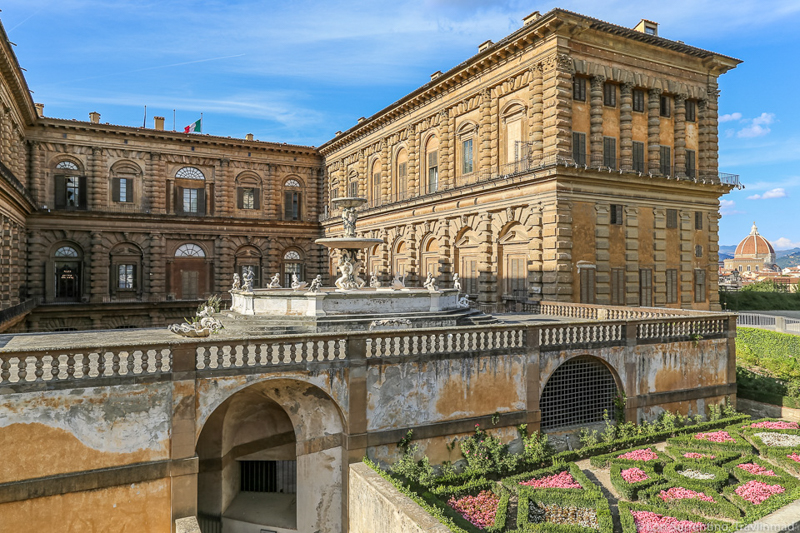
The palace itself is a bit of a mystery when it comes to the original design and its intent. Some say it was commissioned to rival the residences of the ruling Medicis, but most agree on one thing. The design is considered severe in size and scale, and devoid of the grandeur for which the Medici family was known. Ironically, it was sold to the ruling family in 1549.
Visitors can tour much of the palace interior, which includes four museums/galleries and the extensive gardens outside, formally known as Boboli Gardens. Here, there are more than enough photo ops to keep you transfixed for hours. There are steps leading to hidden terraces, Renaissance statues and modern sculpture. Plan on visiting on a sunny day.
Palazzo Pitti is situated on the south side of the River Arno, and the best way to arrive at the palace is simply to walk: over the famous Ponte Vecchio, past buildings and shops that are centuries old. A short walk into Oltrarno brings you to the large front lawn with its carriage lane leading up to the entrance of the great palace.
PRO TIP: The 16th century Forte di Belvidere is accessible via a foot path from the palace, and definitely worth a side visit. The panoramic view of the city from atop this terrace is like no other.
Text and photo by Lori from Travlinmad
READ MORE: 10 Best Things to Do in Florence on Your First Visit!
Château Chenonceau, France
Château Chenonceau in the Loire Valley is among the most popular castles in France.
Château Chenonceau dates back to the 11th century, but the castle as we see today was constructed during the early 1500s. It’s right by the River Cher, which makes it even more picturesque.
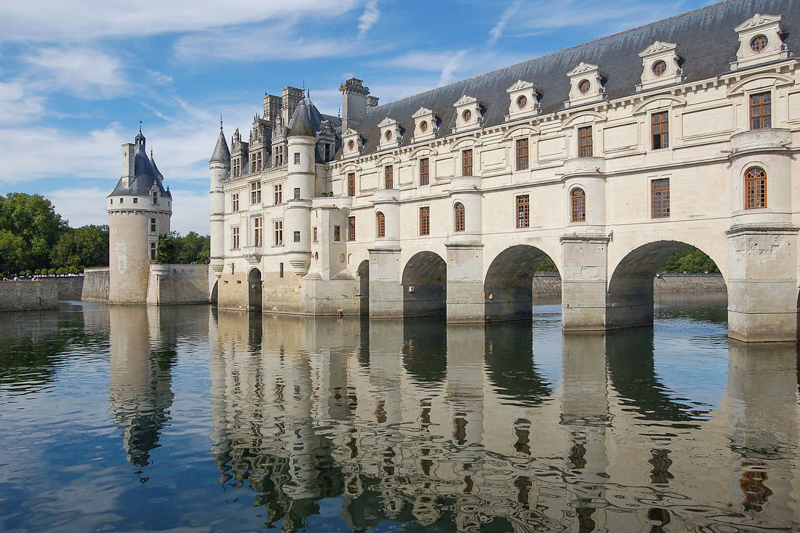
The chateau has quite an intriguing history. Its 16th-century owner King Henry built the castle for his mistress Diane, who built gardens on its grounds.
When the king died as the result of a freak accident, his widow, Catherine de Medici, threw Diane out. Catherine built her own gardens at the chateau, and this is why you’ll see two sets of gardens here!
Visitors to the chateau will appreciate that the interiors are maintained in a way that makes it look as if it’s still inhabited. Every room has fresh floral arrangements and the furnishings look as if they’re still in daily use.
Other places that you must see in this chateau are the art gallery, wine cellar, donkey park and the lovely gardens surrounding the beautiful palace.
Château Chenonceau can be easily reached from Paris. Take a train from Paris Montparnasse 1 Et 2 to St. Pierre des Corps, then another train from St. Pierre des Corps to Chenonceaux. The train rides can take up to 2.5 hours one way.
The train to Chenonceaux is every 2 hours, so plan such that you don’t have to wait long between connections.
Get the audio guide, so you can learn more about the chateau and its colorful history. The best time to get here is during the late afternoon, a couple of hours before the chateau closes down, to avoid the tours that arrive in the morning.
PRO TIP: Getting here in the afternoon also gives photography enthusiasts the best time to capture the chateau’s beauty as the sun’s golden rays cover the chateau.
Text and photo by Christine from The Travelling Pinoys
Tatoi Palace, Greece
A visit to the Tatoi Palace is one of the best alternative things to do in Athens. The ornate structure sits amidst a beautiful forest on the slopes of Mount Parnitha.
Deciduous groves, dense pine forests, and rolling green hills encompass the palace. Not only is the structure beautiful on its own, this is also a wonderful place to combine a trip to the palace with a picnic in the Tatoi gardens, or a hike through the footpaths of nearby Parnitha.
Tatoi Palace was once owned by the Greek royal family, who used it as their summer getaway. George I was the first Greek royal to own the palace when he purchased it in the 1800s.
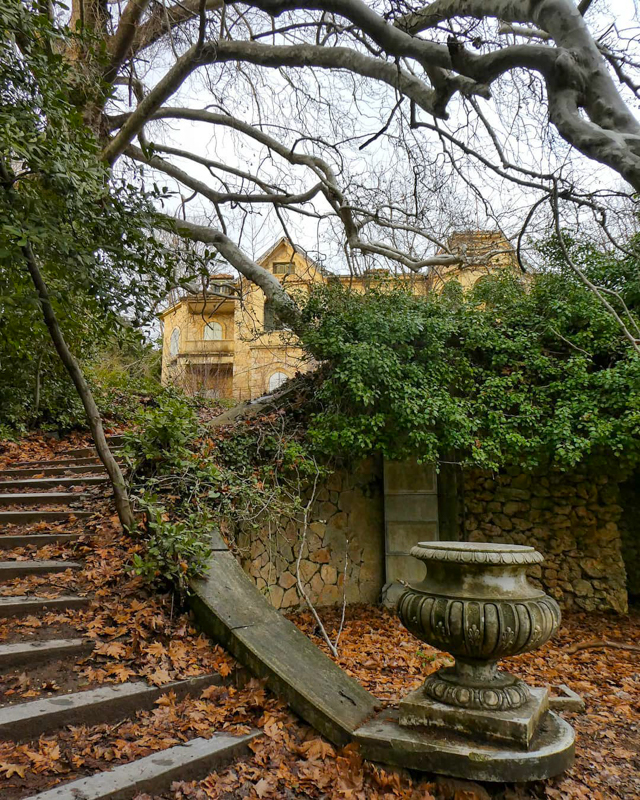
Sadly, today the palace lies abandoned. Once Greece became a republic, the monarchy was disbanded. However, the fact that the property is abandoned does not detract from its beauty. If anything, it adds an air of mystery to it.
You need to take a bus from Athens centre to Mesonychid to get to Tatoi Palace. From Mesonychid, take a cab the remainder of the way. The palace is situated on the outskirts of town and is free to enter.
PRO TIP: Very few tourists know about this place. The benefit is that you can visit here any time of day and you will not be met with huge crowds.
Text and photo by Melissa from High Heels And A Backpack
Palácio de Mafra, Portugal
The Royal Building of Mafra in Portugal is an enormous palace-monastery complex located northwest of Lisbon. The imposing quadrangular building was built in the middle of the 18th century, in the Baroque and neoclassical styles.
The complex is one of the most remarkable works undertaken by King João V, and reflects the power of the Portuguese Empire. Built in limestone and marble, the exceptional example of Italian Baroque covers an area of almost four hectares.
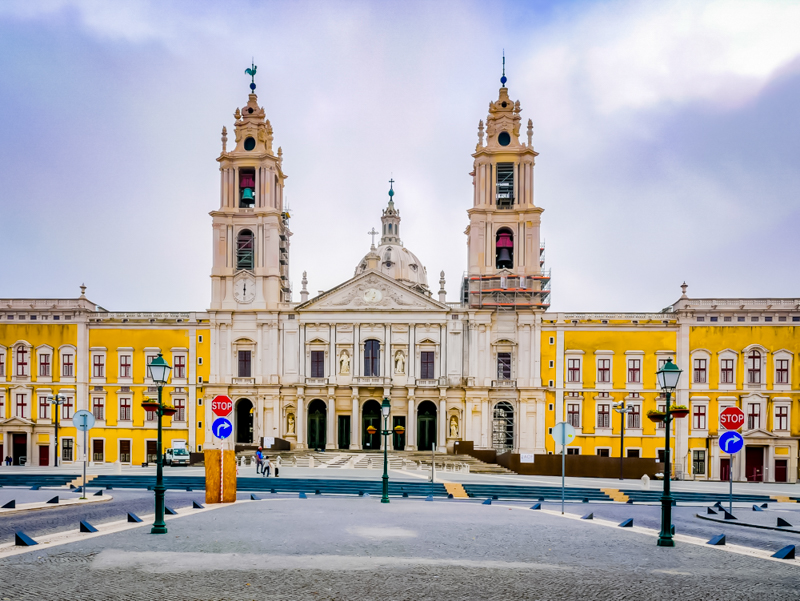
The structure contains 1,200 rooms, more than 4,700 doors and windows, 156 stairways, and 29 inner yards and courtyards. Such magnificence was only possible due to the Brazilian gold brought to the country.
The palaces of the king and queen are located in two turrets of the building. The north turret was occupied by the king and the south turret by the queen, and both turrets are linked by a long palatial corridor, the largest in Europe.
The Royal Building also includes the royal chapel, shaped like a Roman baroque basilica, a Franciscan monastery, and a library containing 36,000 volumes. This library is considered to be one of the most beautiful in the world.
The Cerco garden and the royal hunting park (Tapada) adds even more awesomeness to the complex. The last king of Portugal, Manuel II, left for exile from there in 1910, following the proclamation of the Republic.
After that, the Royal Palace was opened as a museum in 1911 as the Palácio Nacional de Mafra. The Royal Building of Mafra is one the UNESCO World Heritage sites in Portugal.
If you do not have a car, take a taxi or an Uber to the Royal Building of Mafra from Lisbon. If you wish to use public transport, take the subway to Campo Grande and a bus from Campo Grande to the Mafra Convent. Or join a guided tour!
Spring and fall are great times to visit as daytime temperatures are pleasant and you will be able to tour the gardens comfortably.
Text and photo by Anita from Sane Travels
Rundāle Palace, Latvia
Approaching Rundāle Palace feels like being dropped into a scene of “Anastasia.” Tucked into Latvia’s secluded countryside, Rundāle Palace is a hidden gem that has been nearly untouched by the hands of time. The palace’s brilliant, bright, clean lines, in Baroque-style architecture, make it extraordinary and unlike any palace you’ve visited before.
Rundāle Palace has been described as the Baroque pearl of palaces. The bright yellow exterior of the palace makes it nothing short of notable. The interior of the palace is a pristine match to its picturesque interior.
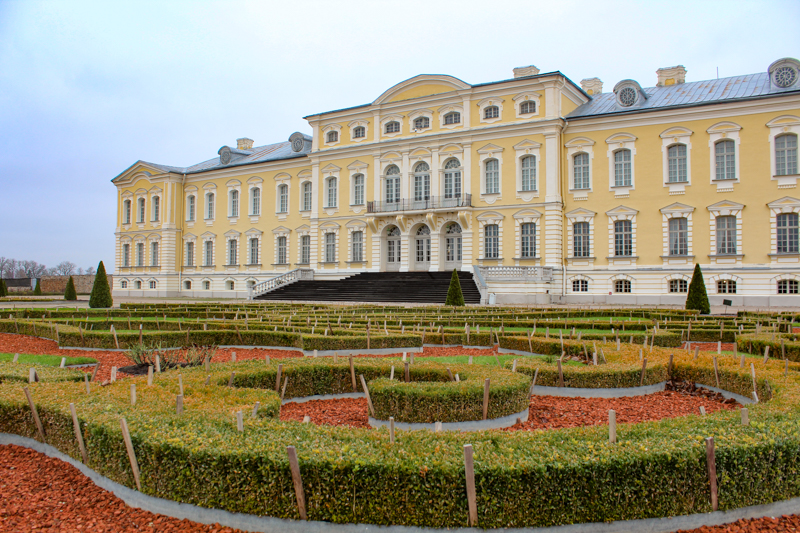
Your historic guides in the palace will don authentic garbs won during the height of Rundāle Palace’s reign. One of the first stops is a mirrored ballroom where they teach you how to twirl and curtsy, transporting you to a glorious, Cinderella-like ball.
Your tour guides will lead you through each corridor and room, emphasizing the importance of the different color palettes used and how the imported materials emphasized wealth and glory.
During a brief stop in the billiard room, your hosts will teach you about fan-carrying etiquette, including the salacious invitations married men and women signaled to their lovers during exquisite balls and parties.
This tour does more than highlight the brilliantly decorated ceilings and imported porcelain and china, it accurately gives you a sense of what it was like to interact and be in the presence of royalty.
The gardens of Rundāle Palace are also worth a relaxing stroll. The hedges and paths are expertly manicured and held in high regard around the world.
Rundāle Palace perfectly encompasses a period of history not often represented on the global stage. It definitely is worth a visit when you in the area.
Rundale Palace is located an hour and 15 minutes outside of Riga and can be reached by bus or by scheduling a tour. Since it’s located off the beaten path, Rundāle Palace is relatively quiet and does not heavy tourist foot traffic.
Text and photo by Martha from The Quirky Globetrotter
Christiansborg Palace, Denmark
The Christiansborg Palace stands on Slotsholmen in the center of Copenhagen, surrounded by some of the many canals that flow through the city.
The Christiansborg Palace has a fascinating history. Castles and palaces have been built on the site for 800 years. Tragically the castle has burnt down twice, in 1794 and 1884, taking all its history with it.
The current palace was built in 1928, but is no longer used as a royal residence. Instead it is where the Queen, the Prime Minister, and the Danish Parliament all conduct their work.
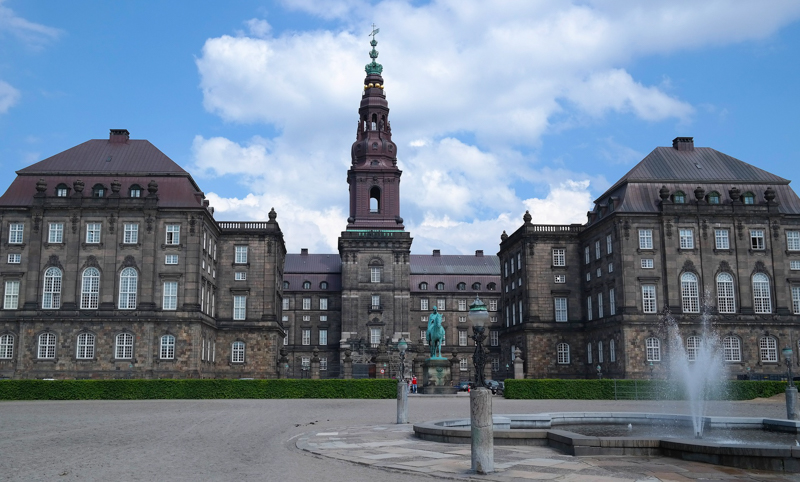
Along with great works of art, statues and ruins, the Great Hall in the palace is home to a magnificent collection of 17 tapestries from Viking times to modern times.
You can explore the ruins of the 12th century Copenhagen Castle under the palace. It was built by Bishop Absalon to keep out the Wendish pirates who attacked the city.
It is free to climb the 106-metre high Tower, the highest tower in Copenhagen. From the top, you get amazing views over the city.
At the rear of the Palace are the Royal Stables, where you can see the white horses that draw the royal carriages, and also learn about the history of the stables through the well-preserved carriages and coaches.
There are guided tours available to take you around each of the areas: Royal Reception Rooms, Royal Kitchens, Royal Stables and the Ruins, or you can walk around and explore on your own.
Text by Larch from The Silver Nomad
*****
So there you have it: the very best palaces in Europe to put on your bucket list! How many have you visited?
You May Also Like
Europe: The Best 10-Day Europe Itineraries!
Europe: The Best National Parks in Europe
Europe: The Best Christmas Markets in Europe!
Europe: The Best Places to Visit in Europe in Winter
Italy: The Most Spectacular UNESCO Sites in Italy
Spain: The Monuments You Must See in Andalusia
Italy: Extraordinary Places to Visit in Northern Italy
Slovenia: The Most Beautiful Places in Slovenia
Montenegro: 25 Amazing Things to Do in Montenegro
Europe: How to Spend 7 Days in Europe!
Did you find this article informative? Pin it for later reference!
